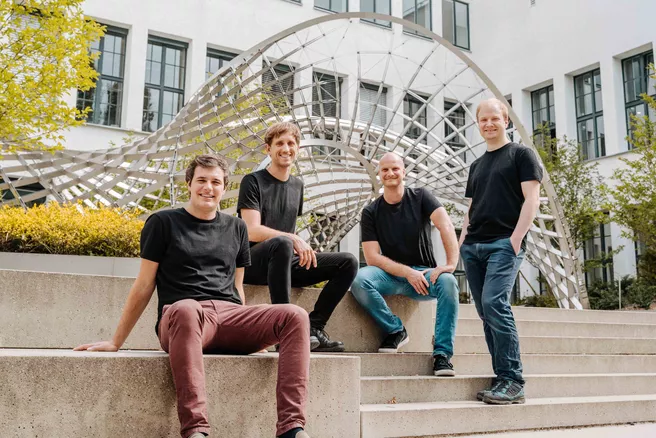Interview: Cornelia Freund
ED: How did your team come together?
Florian Bauer: It all started as a research project at the Technical University of Munich (TUM), then in 2019 we founded Kite. The co-founders came together from different disciplines: Max Isensee is an environmental engineer and takes care of business development. Christoph Drexler and André Frirdich are mechanical engineers with a strong background in aero-wind power and rotor aerodynamics. The two are responsible for the mechanical and aerodynamic components of the turbine development. I am an electrical engineer and responsible for electronics and software algorithms.
What is the technology behind the airborne wind turbines?
The technology consists of a multicopter drone with wings connected to a ground station by a cable. The power-generating kite, made of aluminum and carbon, flies in horizontal figure eights or circles, comparable to the blade tips of a conventional wind turbine, at heights of up to 500 meters (the hub height of wind turbines in Germany averages 130 meters). Instead of a large generator on a tower, the leashed autonomous kite generates most of its energy through the propellers - small onboard wind turbines - and thus uses virtually only the most effective parts to generate energy. Thus, our turbines do not require hundreds of tons of concrete and steel for a tower and foundation, but only a thin electro-mechanical tether and software algorithms. Electric cables integrated into the rope transmit the generated electricity.
You secured $1.6 million in December 2022. How are you investing the capital?
We were hugely excited to receive the funding, and will use the funds to take the technology from prototype to a grid-connected, scaled-up product demonstrator that, if all goes well, will also feed energy into the grid for the first time. To this end, we have prepared a pilot installation and secured a new test site near Munich in preparation for installation this year. We are also currently strengthening our team in the critical areas of software development and power electronics. The goal is to develop a saleable product that will help reduce the environmental impact of power generation.
When will your systems be available on the market and ready for use?
We want to launch the first products on the market by 2024. These will be 100-kilowatt kites with a rope length of 150 meters and a span of ten meters. At the moment, we are already working with farms and communities for which the electricity could be available. Step by step, we then want to develop systems for microgrids and grid feeding, scaling up to 500 kilowatts and later into the megawatt range - and at a price of five to ten cents per kilowatt hour, depending on the location.
We are flying test systems near Oberhaching and Otterfing and working with farmers, municipalities and grid operators. We are experiencing a great deal of openness for our product, including from the authorities. Because it is clear that we are a long way from being climate neutral. We will not achieve the energy turnaround with photovoltaics alone; only together with wind power will this goal be attainable. I am sure that the kites will sell like hot cakes.
How do simulation models - digital twins - help you in product development?
You could say: At its core, Kitekraft is a software company with hardware components. Digital twins have been a focus from the very beginning. For example, I worked on technical and economic simulation models of flying wind turbines in my dissertation. And the results were so promising that they gave rise to our startup. Even now, we fly the kite extensively in simulations and use Monte Carlo analyses, for example, before it takes to the air.
What hurdles and challenges are you currently facing?
We are currently working mainly on the technology. The kite has to fly reliably, and above all it has to generate power and take off and land completely autonomously, safely and reliably. Fail-safe redundant sensors, small and thus lightweight components, waterproof processing: all of these homework tasks are at the forefront for us in terms of economic efficiency. That's why things may seem pretty quiet on the outside, but internally we're working at full speed to get to product maturity.
More information and links:
Kitekraft: www.kitekraft.de
Chair of Wind Energy: www.epe.ed.tum.de/wind
Chair of High-Power Converter Systems: www.epe.ed.tum.de/hlu
